Light Rail Transit System Analysis
VerifiedAdded on 2020/03/28
|15
|3436
|111
AI Summary
This assignment delves into the analysis of light rail transit (LRT) systems, examining their performance and cost-effectiveness. Students will research various aspects of LRT, including operational efficiency, ridership patterns, infrastructure costs, and economic benefits. The aim is to evaluate the strengths and weaknesses of LRT as a sustainable transportation solution and understand its impact on urban environments.
Contribute Materials
Your contribution can guide someone’s learning journey. Share your
documents today.

Running head: Light Rail Network 1
Light Rail Network
Name
Affiliate Institution
Light Rail Network
Name
Affiliate Institution
Secure Best Marks with AI Grader
Need help grading? Try our AI Grader for instant feedback on your assignments.
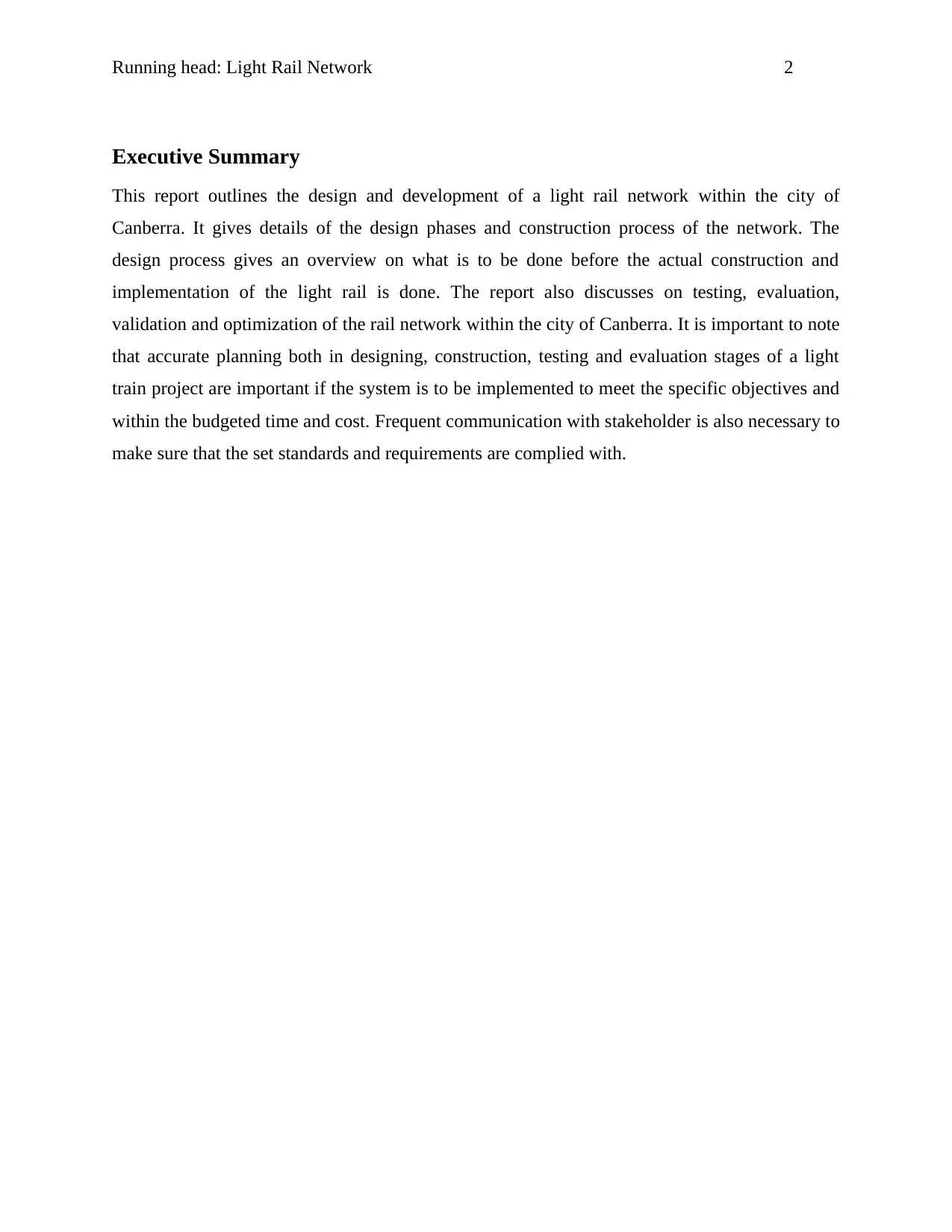
Running head: Light Rail Network 2
Executive Summary
This report outlines the design and development of a light rail network within the city of
Canberra. It gives details of the design phases and construction process of the network. The
design process gives an overview on what is to be done before the actual construction and
implementation of the light rail is done. The report also discusses on testing, evaluation,
validation and optimization of the rail network within the city of Canberra. It is important to note
that accurate planning both in designing, construction, testing and evaluation stages of a light
train project are important if the system is to be implemented to meet the specific objectives and
within the budgeted time and cost. Frequent communication with stakeholder is also necessary to
make sure that the set standards and requirements are complied with.
Executive Summary
This report outlines the design and development of a light rail network within the city of
Canberra. It gives details of the design phases and construction process of the network. The
design process gives an overview on what is to be done before the actual construction and
implementation of the light rail is done. The report also discusses on testing, evaluation,
validation and optimization of the rail network within the city of Canberra. It is important to note
that accurate planning both in designing, construction, testing and evaluation stages of a light
train project are important if the system is to be implemented to meet the specific objectives and
within the budgeted time and cost. Frequent communication with stakeholder is also necessary to
make sure that the set standards and requirements are complied with.
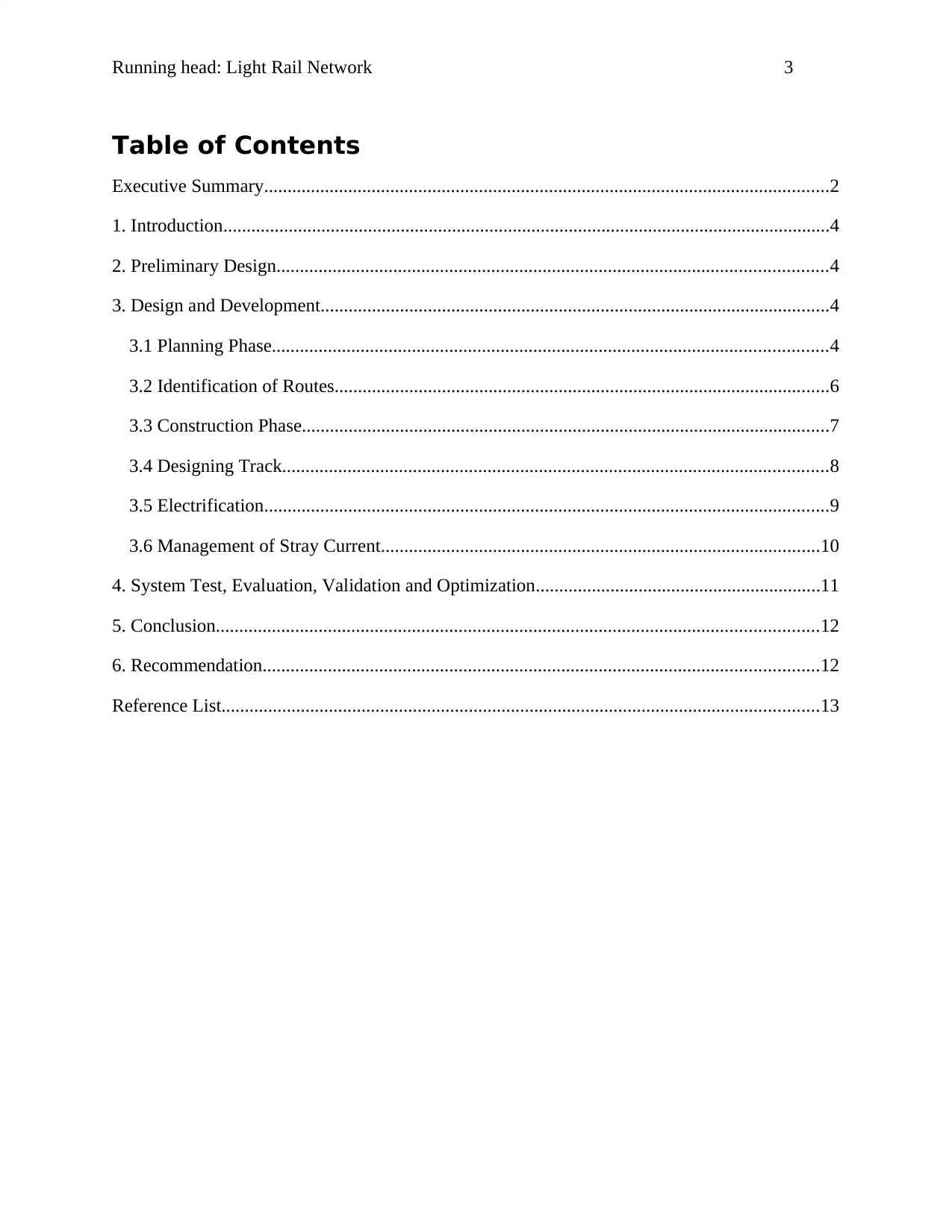
Running head: Light Rail Network 3
Table of Contents
Executive Summary.........................................................................................................................2
1. Introduction..................................................................................................................................4
2. Preliminary Design......................................................................................................................4
3. Design and Development.............................................................................................................4
3.1 Planning Phase.......................................................................................................................4
3.2 Identification of Routes..........................................................................................................6
3.3 Construction Phase.................................................................................................................7
3.4 Designing Track.....................................................................................................................8
3.5 Electrification.........................................................................................................................9
3.6 Management of Stray Current..............................................................................................10
4. System Test, Evaluation, Validation and Optimization.............................................................11
5. Conclusion.................................................................................................................................12
6. Recommendation.......................................................................................................................12
Reference List................................................................................................................................13
Table of Contents
Executive Summary.........................................................................................................................2
1. Introduction..................................................................................................................................4
2. Preliminary Design......................................................................................................................4
3. Design and Development.............................................................................................................4
3.1 Planning Phase.......................................................................................................................4
3.2 Identification of Routes..........................................................................................................6
3.3 Construction Phase.................................................................................................................7
3.4 Designing Track.....................................................................................................................8
3.5 Electrification.........................................................................................................................9
3.6 Management of Stray Current..............................................................................................10
4. System Test, Evaluation, Validation and Optimization.............................................................11
5. Conclusion.................................................................................................................................12
6. Recommendation.......................................................................................................................12
Reference List................................................................................................................................13
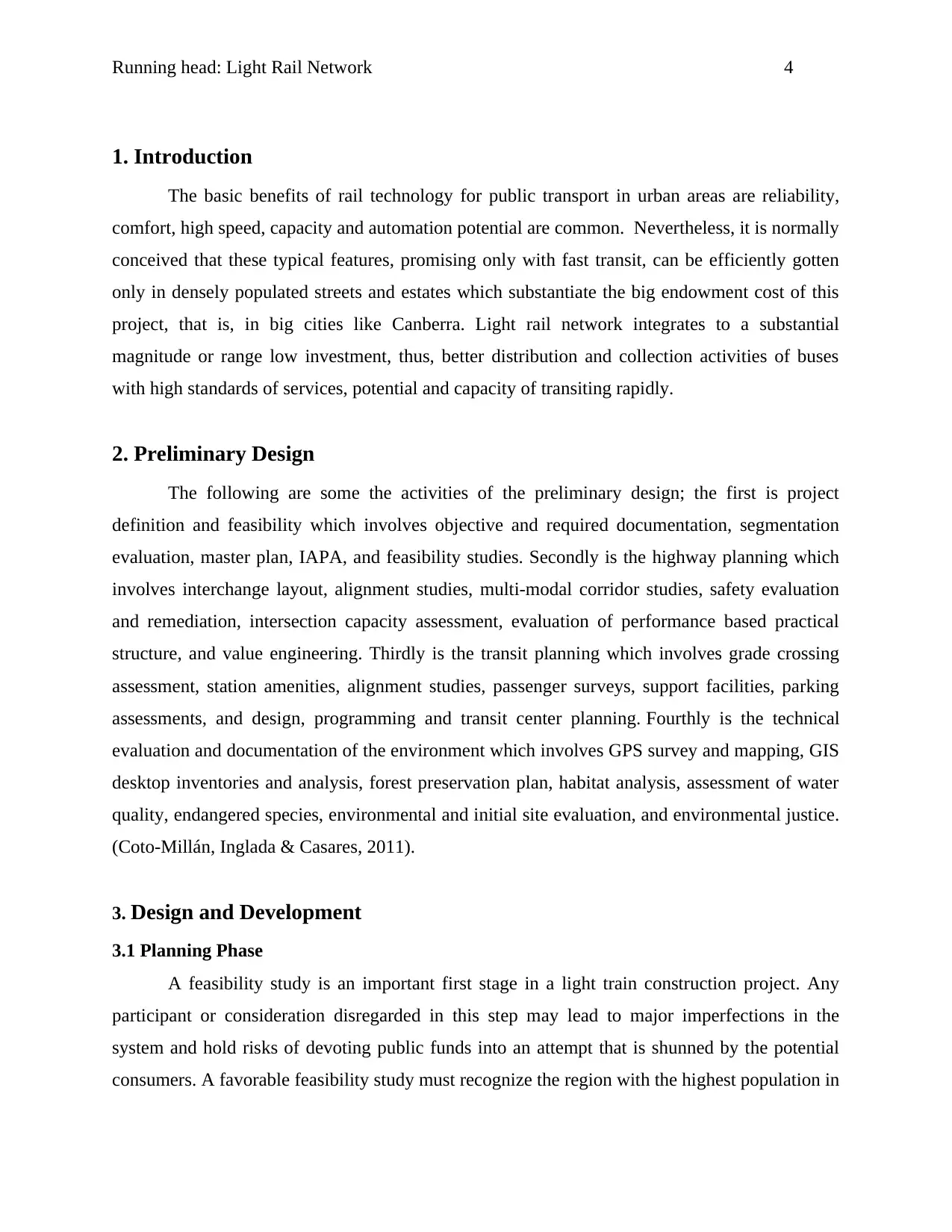
Running head: Light Rail Network 4
1. Introduction
The basic benefits of rail technology for public transport in urban areas are reliability,
comfort, high speed, capacity and automation potential are common. Nevertheless, it is normally
conceived that these typical features, promising only with fast transit, can be efficiently gotten
only in densely populated streets and estates which substantiate the big endowment cost of this
project, that is, in big cities like Canberra. Light rail network integrates to a substantial
magnitude or range low investment, thus, better distribution and collection activities of buses
with high standards of services, potential and capacity of transiting rapidly.
2. Preliminary Design
The following are some the activities of the preliminary design; the first is project
definition and feasibility which involves objective and required documentation, segmentation
evaluation, master plan, IAPA, and feasibility studies. Secondly is the highway planning which
involves interchange layout, alignment studies, multi-modal corridor studies, safety evaluation
and remediation, intersection capacity assessment, evaluation of performance based practical
structure, and value engineering. Thirdly is the transit planning which involves grade crossing
assessment, station amenities, alignment studies, passenger surveys, support facilities, parking
assessments, and design, programming and transit center planning. Fourthly is the technical
evaluation and documentation of the environment which involves GPS survey and mapping, GIS
desktop inventories and analysis, forest preservation plan, habitat analysis, assessment of water
quality, endangered species, environmental and initial site evaluation, and environmental justice.
(Coto-Millán, Inglada & Casares, 2011).
3. Design and Development
3.1 Planning Phase
A feasibility study is an important first stage in a light train construction project. Any
participant or consideration disregarded in this step may lead to major imperfections in the
system and hold risks of devoting public funds into an attempt that is shunned by the potential
consumers. A favorable feasibility study must recognize the region with the highest population in
1. Introduction
The basic benefits of rail technology for public transport in urban areas are reliability,
comfort, high speed, capacity and automation potential are common. Nevertheless, it is normally
conceived that these typical features, promising only with fast transit, can be efficiently gotten
only in densely populated streets and estates which substantiate the big endowment cost of this
project, that is, in big cities like Canberra. Light rail network integrates to a substantial
magnitude or range low investment, thus, better distribution and collection activities of buses
with high standards of services, potential and capacity of transiting rapidly.
2. Preliminary Design
The following are some the activities of the preliminary design; the first is project
definition and feasibility which involves objective and required documentation, segmentation
evaluation, master plan, IAPA, and feasibility studies. Secondly is the highway planning which
involves interchange layout, alignment studies, multi-modal corridor studies, safety evaluation
and remediation, intersection capacity assessment, evaluation of performance based practical
structure, and value engineering. Thirdly is the transit planning which involves grade crossing
assessment, station amenities, alignment studies, passenger surveys, support facilities, parking
assessments, and design, programming and transit center planning. Fourthly is the technical
evaluation and documentation of the environment which involves GPS survey and mapping, GIS
desktop inventories and analysis, forest preservation plan, habitat analysis, assessment of water
quality, endangered species, environmental and initial site evaluation, and environmental justice.
(Coto-Millán, Inglada & Casares, 2011).
3. Design and Development
3.1 Planning Phase
A feasibility study is an important first stage in a light train construction project. Any
participant or consideration disregarded in this step may lead to major imperfections in the
system and hold risks of devoting public funds into an attempt that is shunned by the potential
consumers. A favorable feasibility study must recognize the region with the highest population in
Secure Best Marks with AI Grader
Need help grading? Try our AI Grader for instant feedback on your assignments.

Running head: Light Rail Network 5
basis of size, fare payment capabilities, commuting demand possibilities, and development of
crucial transport links. As such, economic sustainability and viability and sustainability of a
system is achieved. (Lin, Lan & Chang, 2012).
The main idea for an efficient network is to connect the three major kinds of zones, such
as residential areas, central business districts, and the major public transport center, like airports,
railway stations, and bus stations. The formation and locality of each region, the customer flows
between them and economic reasons are the key specification that can will influence the
planning network process. Identifying regions correctly and creation of viable connection
between them is the key to meeting the needed customer flows. Determination of the likely
contribution that the light train network might build to regeneration of urban is another main
factor for an efficient feasibility study. The following are some of the benefits associated with
well-designed light trail system: financial advantages for local firms participating in construction
deals, employment opportunities, new investment in city areas, contribution to a unified transport
system for public, improved access, and congestion and carbon emission minimization. (Yang,
2015).
Figure 1: An integrated tramway station in Nottingham
(Source: Office of Rail and Road 2015)
basis of size, fare payment capabilities, commuting demand possibilities, and development of
crucial transport links. As such, economic sustainability and viability and sustainability of a
system is achieved. (Lin, Lan & Chang, 2012).
The main idea for an efficient network is to connect the three major kinds of zones, such
as residential areas, central business districts, and the major public transport center, like airports,
railway stations, and bus stations. The formation and locality of each region, the customer flows
between them and economic reasons are the key specification that can will influence the
planning network process. Identifying regions correctly and creation of viable connection
between them is the key to meeting the needed customer flows. Determination of the likely
contribution that the light train network might build to regeneration of urban is another main
factor for an efficient feasibility study. The following are some of the benefits associated with
well-designed light trail system: financial advantages for local firms participating in construction
deals, employment opportunities, new investment in city areas, contribution to a unified transport
system for public, improved access, and congestion and carbon emission minimization. (Yang,
2015).
Figure 1: An integrated tramway station in Nottingham
(Source: Office of Rail and Road 2015)
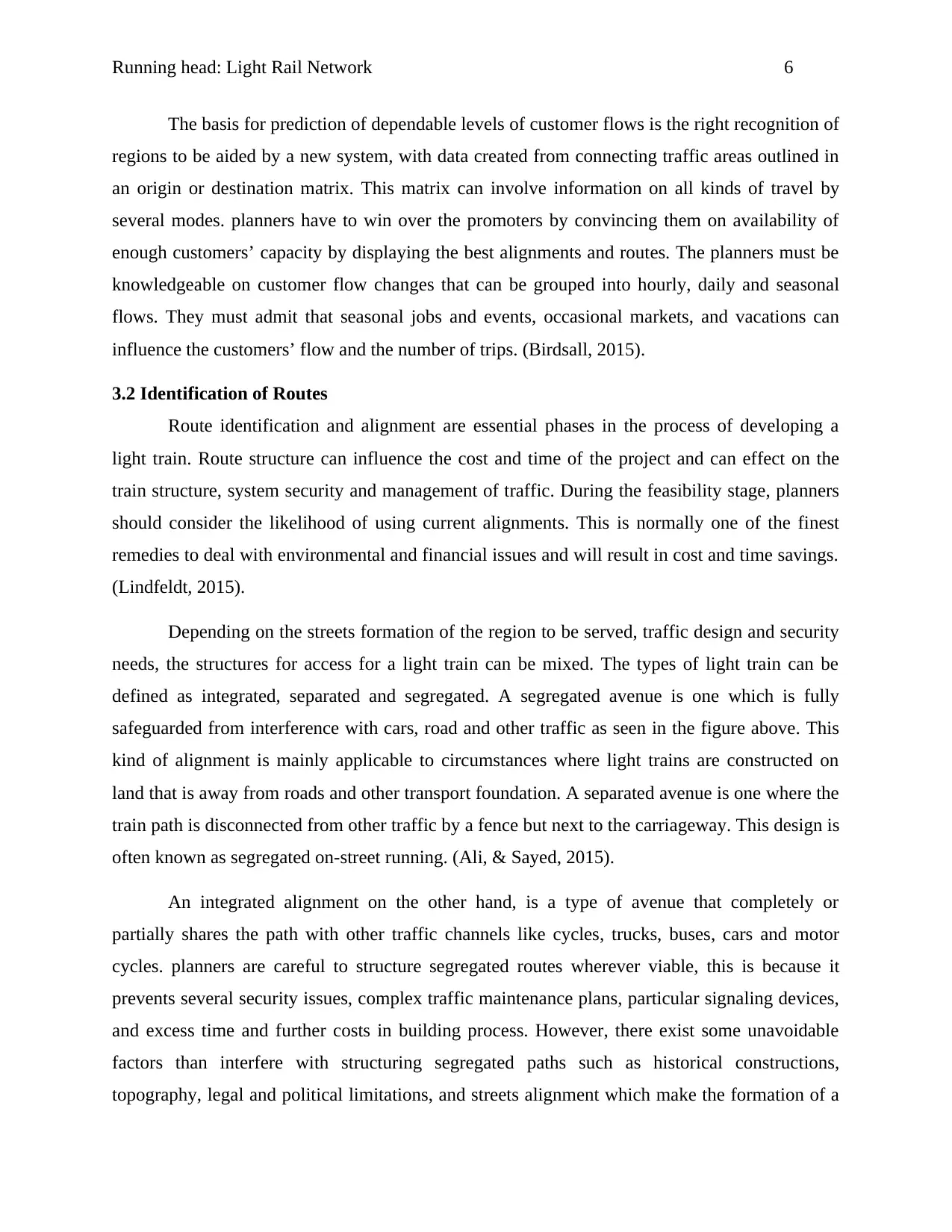
Running head: Light Rail Network 6
The basis for prediction of dependable levels of customer flows is the right recognition of
regions to be aided by a new system, with data created from connecting traffic areas outlined in
an origin or destination matrix. This matrix can involve information on all kinds of travel by
several modes. planners have to win over the promoters by convincing them on availability of
enough customers’ capacity by displaying the best alignments and routes. The planners must be
knowledgeable on customer flow changes that can be grouped into hourly, daily and seasonal
flows. They must admit that seasonal jobs and events, occasional markets, and vacations can
influence the customers’ flow and the number of trips. (Birdsall, 2015).
3.2 Identification of Routes
Route identification and alignment are essential phases in the process of developing a
light train. Route structure can influence the cost and time of the project and can effect on the
train structure, system security and management of traffic. During the feasibility stage, planners
should consider the likelihood of using current alignments. This is normally one of the finest
remedies to deal with environmental and financial issues and will result in cost and time savings.
(Lindfeldt, 2015).
Depending on the streets formation of the region to be served, traffic design and security
needs, the structures for access for a light train can be mixed. The types of light train can be
defined as integrated, separated and segregated. A segregated avenue is one which is fully
safeguarded from interference with cars, road and other traffic as seen in the figure above. This
kind of alignment is mainly applicable to circumstances where light trains are constructed on
land that is away from roads and other transport foundation. A separated avenue is one where the
train path is disconnected from other traffic by a fence but next to the carriageway. This design is
often known as segregated on-street running. (Ali, & Sayed, 2015).
An integrated alignment on the other hand, is a type of avenue that completely or
partially shares the path with other traffic channels like cycles, trucks, buses, cars and motor
cycles. planners are careful to structure segregated routes wherever viable, this is because it
prevents several security issues, complex traffic maintenance plans, particular signaling devices,
and excess time and further costs in building process. However, there exist some unavoidable
factors than interfere with structuring segregated paths such as historical constructions,
topography, legal and political limitations, and streets alignment which make the formation of a
The basis for prediction of dependable levels of customer flows is the right recognition of
regions to be aided by a new system, with data created from connecting traffic areas outlined in
an origin or destination matrix. This matrix can involve information on all kinds of travel by
several modes. planners have to win over the promoters by convincing them on availability of
enough customers’ capacity by displaying the best alignments and routes. The planners must be
knowledgeable on customer flow changes that can be grouped into hourly, daily and seasonal
flows. They must admit that seasonal jobs and events, occasional markets, and vacations can
influence the customers’ flow and the number of trips. (Birdsall, 2015).
3.2 Identification of Routes
Route identification and alignment are essential phases in the process of developing a
light train. Route structure can influence the cost and time of the project and can effect on the
train structure, system security and management of traffic. During the feasibility stage, planners
should consider the likelihood of using current alignments. This is normally one of the finest
remedies to deal with environmental and financial issues and will result in cost and time savings.
(Lindfeldt, 2015).
Depending on the streets formation of the region to be served, traffic design and security
needs, the structures for access for a light train can be mixed. The types of light train can be
defined as integrated, separated and segregated. A segregated avenue is one which is fully
safeguarded from interference with cars, road and other traffic as seen in the figure above. This
kind of alignment is mainly applicable to circumstances where light trains are constructed on
land that is away from roads and other transport foundation. A separated avenue is one where the
train path is disconnected from other traffic by a fence but next to the carriageway. This design is
often known as segregated on-street running. (Ali, & Sayed, 2015).
An integrated alignment on the other hand, is a type of avenue that completely or
partially shares the path with other traffic channels like cycles, trucks, buses, cars and motor
cycles. planners are careful to structure segregated routes wherever viable, this is because it
prevents several security issues, complex traffic maintenance plans, particular signaling devices,
and excess time and further costs in building process. However, there exist some unavoidable
factors than interfere with structuring segregated paths such as historical constructions,
topography, legal and political limitations, and streets alignment which make the formation of a
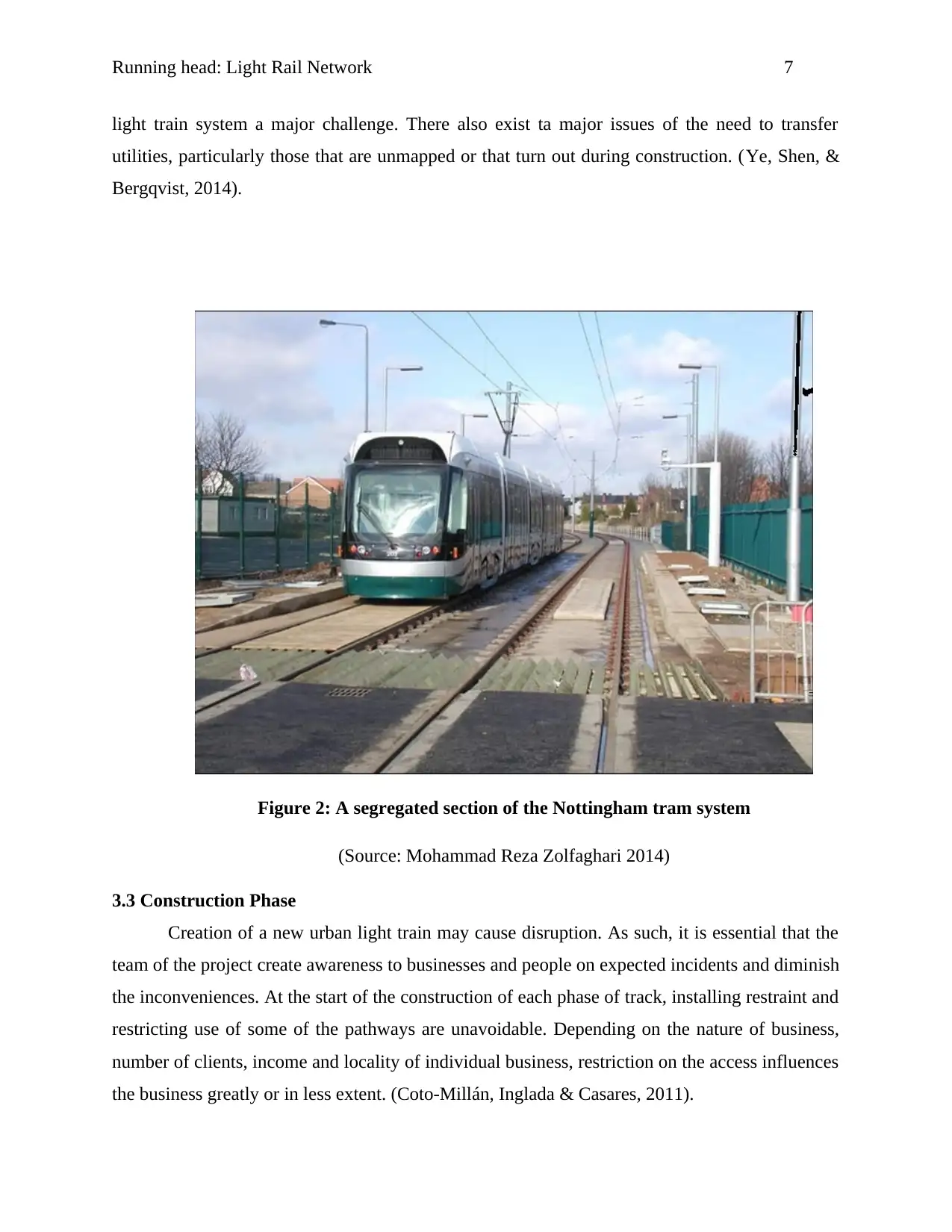
Running head: Light Rail Network 7
light train system a major challenge. There also exist ta major issues of the need to transfer
utilities, particularly those that are unmapped or that turn out during construction. (Ye, Shen, &
Bergqvist, 2014).
Figure 2: A segregated section of the Nottingham tram system
(Source: Mohammad Reza Zolfaghari 2014)
3.3 Construction Phase
Creation of a new urban light train may cause disruption. As such, it is essential that the
team of the project create awareness to businesses and people on expected incidents and diminish
the inconveniences. At the start of the construction of each phase of track, installing restraint and
restricting use of some of the pathways are unavoidable. Depending on the nature of business,
number of clients, income and locality of individual business, restriction on the access influences
the business greatly or in less extent. (Coto-Millán, Inglada & Casares, 2011).
light train system a major challenge. There also exist ta major issues of the need to transfer
utilities, particularly those that are unmapped or that turn out during construction. (Ye, Shen, &
Bergqvist, 2014).
Figure 2: A segregated section of the Nottingham tram system
(Source: Mohammad Reza Zolfaghari 2014)
3.3 Construction Phase
Creation of a new urban light train may cause disruption. As such, it is essential that the
team of the project create awareness to businesses and people on expected incidents and diminish
the inconveniences. At the start of the construction of each phase of track, installing restraint and
restricting use of some of the pathways are unavoidable. Depending on the nature of business,
number of clients, income and locality of individual business, restriction on the access influences
the business greatly or in less extent. (Coto-Millán, Inglada & Casares, 2011).
Paraphrase This Document
Need a fresh take? Get an instant paraphrase of this document with our AI Paraphraser
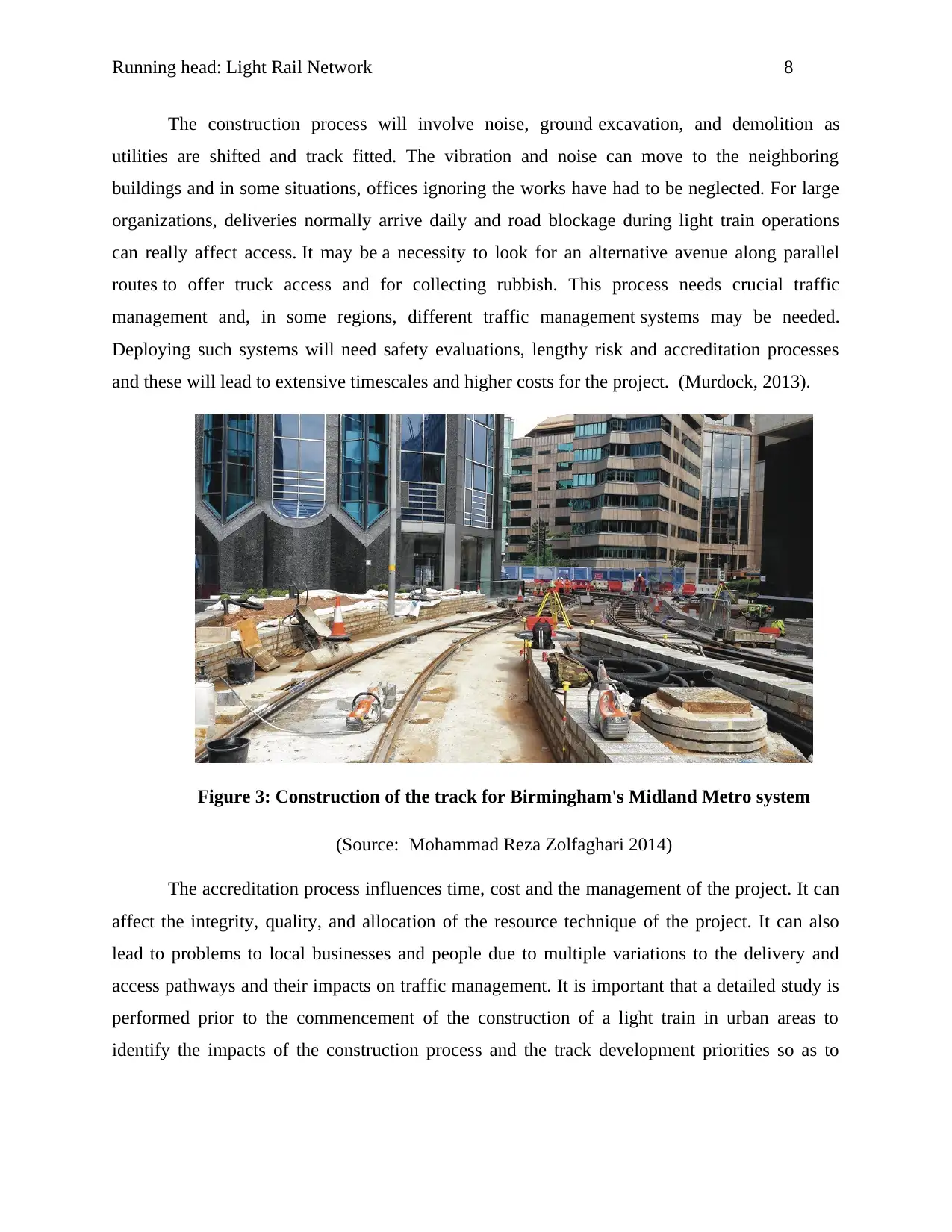
Running head: Light Rail Network 8
The construction process will involve noise, ground excavation, and demolition as
utilities are shifted and track fitted. The vibration and noise can move to the neighboring
buildings and in some situations, offices ignoring the works have had to be neglected. For large
organizations, deliveries normally arrive daily and road blockage during light train operations
can really affect access. It may be a necessity to look for an alternative avenue along parallel
routes to offer truck access and for collecting rubbish. This process needs crucial traffic
management and, in some regions, different traffic management systems may be needed.
Deploying such systems will need safety evaluations, lengthy risk and accreditation processes
and these will lead to extensive timescales and higher costs for the project. (Murdock, 2013).
Figure 3: Construction of the track for Birmingham's Midland Metro system
(Source: Mohammad Reza Zolfaghari 2014)
The accreditation process influences time, cost and the management of the project. It can
affect the integrity, quality, and allocation of the resource technique of the project. It can also
lead to problems to local businesses and people due to multiple variations to the delivery and
access pathways and their impacts on traffic management. It is important that a detailed study is
performed prior to the commencement of the construction of a light train in urban areas to
identify the impacts of the construction process and the track development priorities so as to
The construction process will involve noise, ground excavation, and demolition as
utilities are shifted and track fitted. The vibration and noise can move to the neighboring
buildings and in some situations, offices ignoring the works have had to be neglected. For large
organizations, deliveries normally arrive daily and road blockage during light train operations
can really affect access. It may be a necessity to look for an alternative avenue along parallel
routes to offer truck access and for collecting rubbish. This process needs crucial traffic
management and, in some regions, different traffic management systems may be needed.
Deploying such systems will need safety evaluations, lengthy risk and accreditation processes
and these will lead to extensive timescales and higher costs for the project. (Murdock, 2013).
Figure 3: Construction of the track for Birmingham's Midland Metro system
(Source: Mohammad Reza Zolfaghari 2014)
The accreditation process influences time, cost and the management of the project. It can
affect the integrity, quality, and allocation of the resource technique of the project. It can also
lead to problems to local businesses and people due to multiple variations to the delivery and
access pathways and their impacts on traffic management. It is important that a detailed study is
performed prior to the commencement of the construction of a light train in urban areas to
identify the impacts of the construction process and the track development priorities so as to
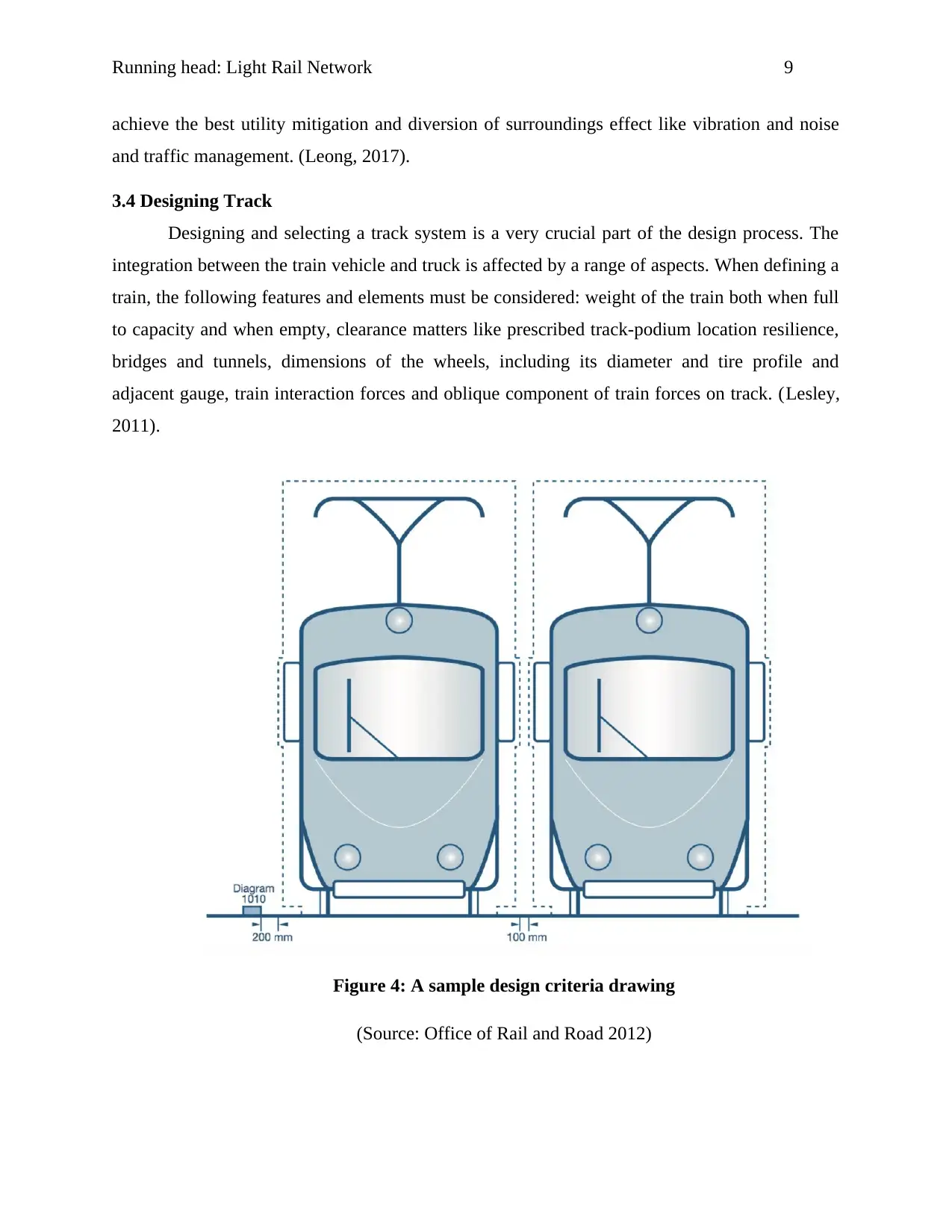
Running head: Light Rail Network 9
achieve the best utility mitigation and diversion of surroundings effect like vibration and noise
and traffic management. (Leong, 2017).
3.4 Designing Track
Designing and selecting a track system is a very crucial part of the design process. The
integration between the train vehicle and truck is affected by a range of aspects. When defining a
train, the following features and elements must be considered: weight of the train both when full
to capacity and when empty, clearance matters like prescribed track-podium location resilience,
bridges and tunnels, dimensions of the wheels, including its diameter and tire profile and
adjacent gauge, train interaction forces and oblique component of train forces on track. (Lesley,
2011).
Figure 4: A sample design criteria drawing
(Source: Office of Rail and Road 2012)
achieve the best utility mitigation and diversion of surroundings effect like vibration and noise
and traffic management. (Leong, 2017).
3.4 Designing Track
Designing and selecting a track system is a very crucial part of the design process. The
integration between the train vehicle and truck is affected by a range of aspects. When defining a
train, the following features and elements must be considered: weight of the train both when full
to capacity and when empty, clearance matters like prescribed track-podium location resilience,
bridges and tunnels, dimensions of the wheels, including its diameter and tire profile and
adjacent gauge, train interaction forces and oblique component of train forces on track. (Lesley,
2011).
Figure 4: A sample design criteria drawing
(Source: Office of Rail and Road 2012)
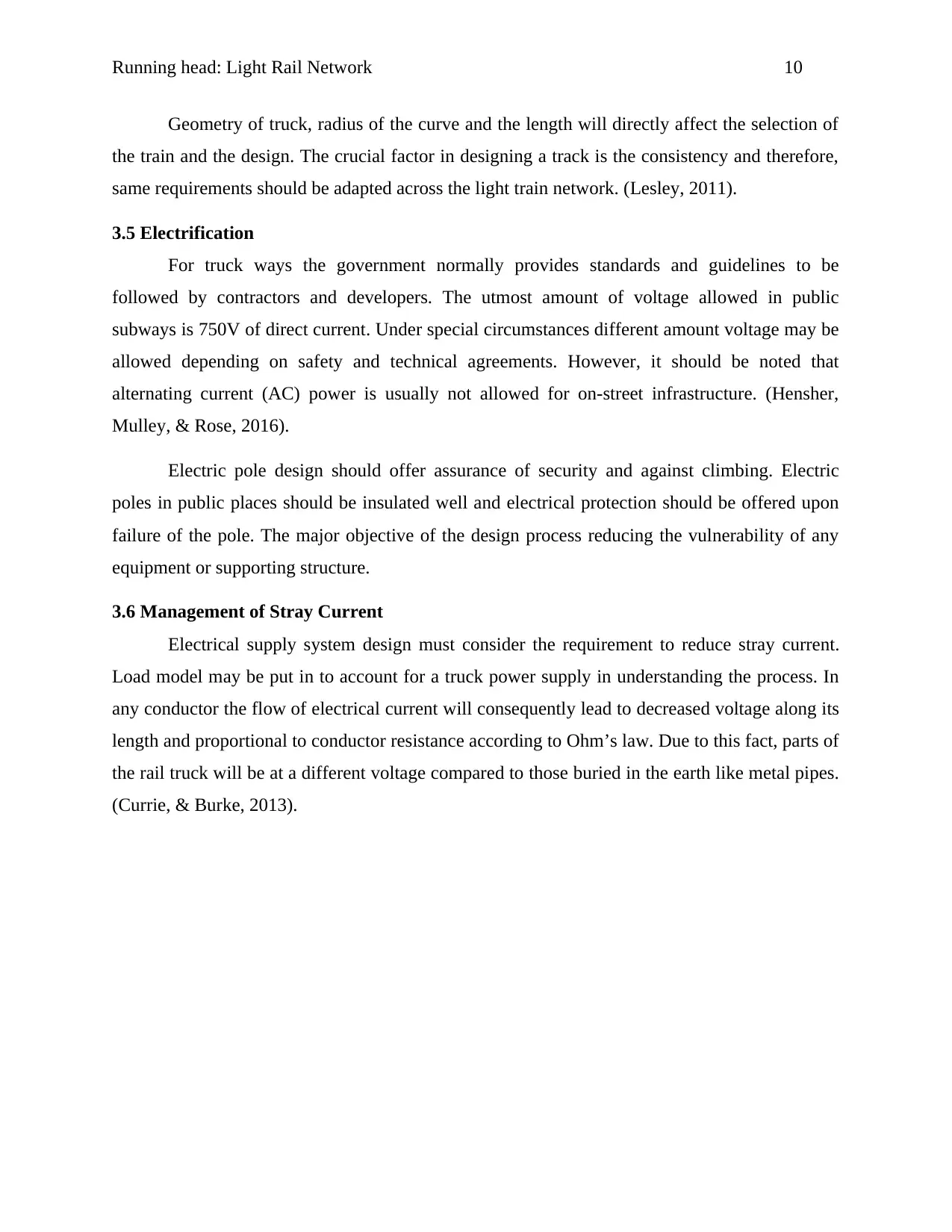
Running head: Light Rail Network 10
Geometry of truck, radius of the curve and the length will directly affect the selection of
the train and the design. The crucial factor in designing a track is the consistency and therefore,
same requirements should be adapted across the light train network. (Lesley, 2011).
3.5 Electrification
For truck ways the government normally provides standards and guidelines to be
followed by contractors and developers. The utmost amount of voltage allowed in public
subways is 750V of direct current. Under special circumstances different amount voltage may be
allowed depending on safety and technical agreements. However, it should be noted that
alternating current (AC) power is usually not allowed for on-street infrastructure. (Hensher,
Mulley, & Rose, 2016).
Electric pole design should offer assurance of security and against climbing. Electric
poles in public places should be insulated well and electrical protection should be offered upon
failure of the pole. The major objective of the design process reducing the vulnerability of any
equipment or supporting structure.
3.6 Management of Stray Current
Electrical supply system design must consider the requirement to reduce stray current.
Load model may be put in to account for a truck power supply in understanding the process. In
any conductor the flow of electrical current will consequently lead to decreased voltage along its
length and proportional to conductor resistance according to Ohm’s law. Due to this fact, parts of
the rail truck will be at a different voltage compared to those buried in the earth like metal pipes.
(Currie, & Burke, 2013).
Geometry of truck, radius of the curve and the length will directly affect the selection of
the train and the design. The crucial factor in designing a track is the consistency and therefore,
same requirements should be adapted across the light train network. (Lesley, 2011).
3.5 Electrification
For truck ways the government normally provides standards and guidelines to be
followed by contractors and developers. The utmost amount of voltage allowed in public
subways is 750V of direct current. Under special circumstances different amount voltage may be
allowed depending on safety and technical agreements. However, it should be noted that
alternating current (AC) power is usually not allowed for on-street infrastructure. (Hensher,
Mulley, & Rose, 2016).
Electric pole design should offer assurance of security and against climbing. Electric
poles in public places should be insulated well and electrical protection should be offered upon
failure of the pole. The major objective of the design process reducing the vulnerability of any
equipment or supporting structure.
3.6 Management of Stray Current
Electrical supply system design must consider the requirement to reduce stray current.
Load model may be put in to account for a truck power supply in understanding the process. In
any conductor the flow of electrical current will consequently lead to decreased voltage along its
length and proportional to conductor resistance according to Ohm’s law. Due to this fact, parts of
the rail truck will be at a different voltage compared to those buried in the earth like metal pipes.
(Currie, & Burke, 2013).
Secure Best Marks with AI Grader
Need help grading? Try our AI Grader for instant feedback on your assignments.
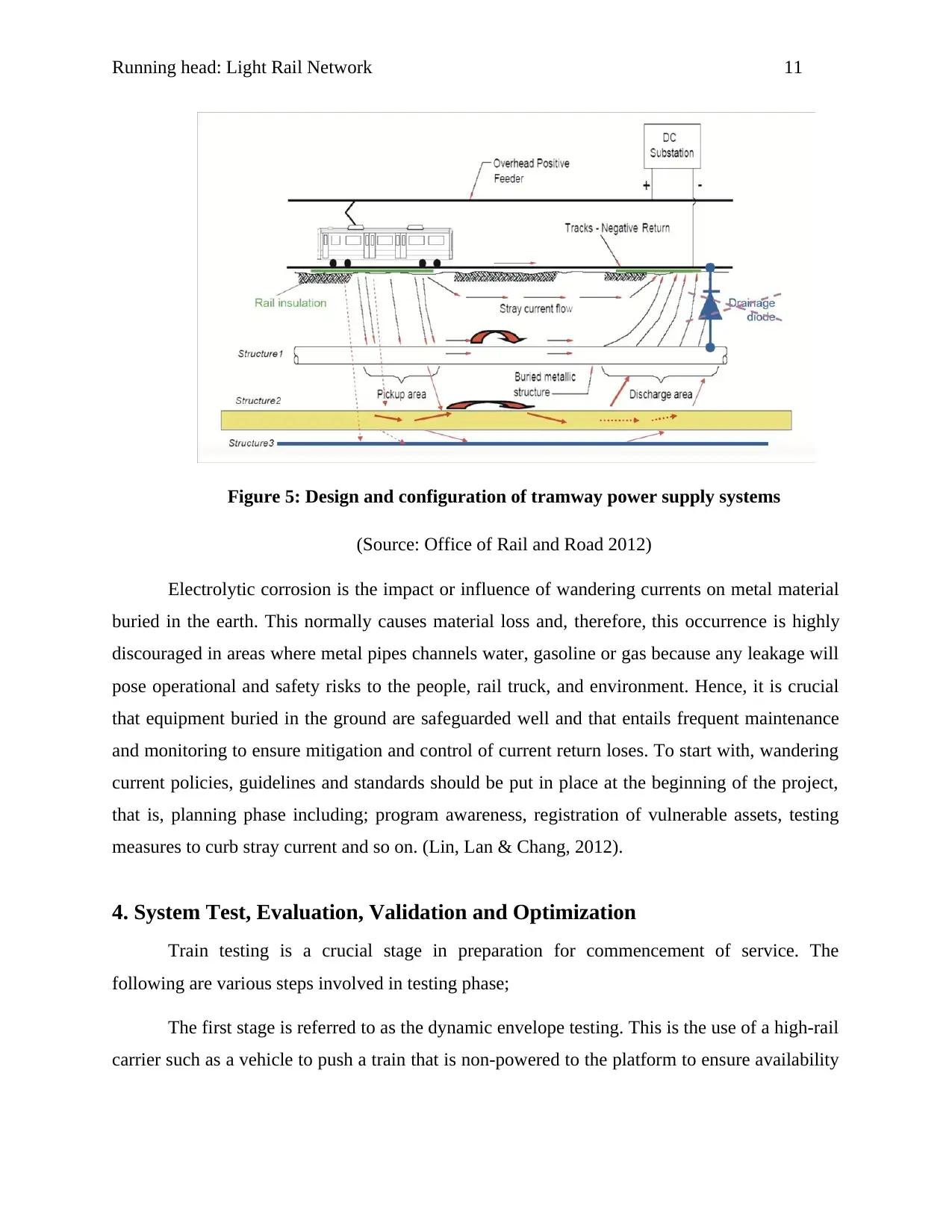
Running head: Light Rail Network 11
Figure 5: Design and configuration of tramway power supply systems
(Source: Office of Rail and Road 2012)
Electrolytic corrosion is the impact or influence of wandering currents on metal material
buried in the earth. This normally causes material loss and, therefore, this occurrence is highly
discouraged in areas where metal pipes channels water, gasoline or gas because any leakage will
pose operational and safety risks to the people, rail truck, and environment. Hence, it is crucial
that equipment buried in the ground are safeguarded well and that entails frequent maintenance
and monitoring to ensure mitigation and control of current return loses. To start with, wandering
current policies, guidelines and standards should be put in place at the beginning of the project,
that is, planning phase including; program awareness, registration of vulnerable assets, testing
measures to curb stray current and so on. (Lin, Lan & Chang, 2012).
4. System Test, Evaluation, Validation and Optimization
Train testing is a crucial stage in preparation for commencement of service. The
following are various steps involved in testing phase;
The first stage is referred to as the dynamic envelope testing. This is the use of a high-rail
carrier such as a vehicle to push a train that is non-powered to the platform to ensure availability
Figure 5: Design and configuration of tramway power supply systems
(Source: Office of Rail and Road 2012)
Electrolytic corrosion is the impact or influence of wandering currents on metal material
buried in the earth. This normally causes material loss and, therefore, this occurrence is highly
discouraged in areas where metal pipes channels water, gasoline or gas because any leakage will
pose operational and safety risks to the people, rail truck, and environment. Hence, it is crucial
that equipment buried in the ground are safeguarded well and that entails frequent maintenance
and monitoring to ensure mitigation and control of current return loses. To start with, wandering
current policies, guidelines and standards should be put in place at the beginning of the project,
that is, planning phase including; program awareness, registration of vulnerable assets, testing
measures to curb stray current and so on. (Lin, Lan & Chang, 2012).
4. System Test, Evaluation, Validation and Optimization
Train testing is a crucial stage in preparation for commencement of service. The
following are various steps involved in testing phase;
The first stage is referred to as the dynamic envelope testing. This is the use of a high-rail
carrier such as a vehicle to push a train that is non-powered to the platform to ensure availability
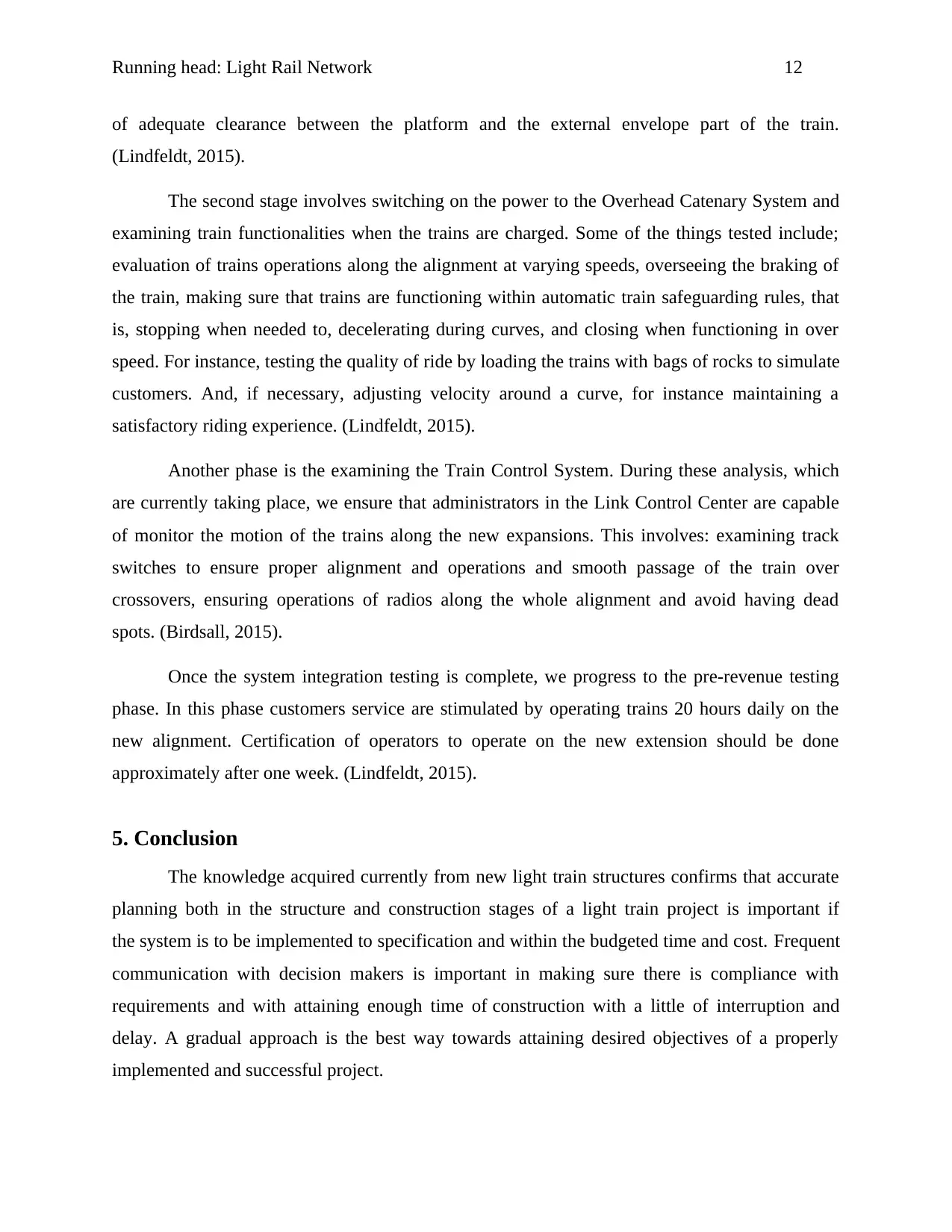
Running head: Light Rail Network 12
of adequate clearance between the platform and the external envelope part of the train.
(Lindfeldt, 2015).
The second stage involves switching on the power to the Overhead Catenary System and
examining train functionalities when the trains are charged. Some of the things tested include;
evaluation of trains operations along the alignment at varying speeds, overseeing the braking of
the train, making sure that trains are functioning within automatic train safeguarding rules, that
is, stopping when needed to, decelerating during curves, and closing when functioning in over
speed. For instance, testing the quality of ride by loading the trains with bags of rocks to simulate
customers. And, if necessary, adjusting velocity around a curve, for instance maintaining a
satisfactory riding experience. (Lindfeldt, 2015).
Another phase is the examining the Train Control System. During these analysis, which
are currently taking place, we ensure that administrators in the Link Control Center are capable
of monitor the motion of the trains along the new expansions. This involves: examining track
switches to ensure proper alignment and operations and smooth passage of the train over
crossovers, ensuring operations of radios along the whole alignment and avoid having dead
spots. (Birdsall, 2015).
Once the system integration testing is complete, we progress to the pre-revenue testing
phase. In this phase customers service are stimulated by operating trains 20 hours daily on the
new alignment. Certification of operators to operate on the new extension should be done
approximately after one week. (Lindfeldt, 2015).
5. Conclusion
The knowledge acquired currently from new light train structures confirms that accurate
planning both in the structure and construction stages of a light train project is important if
the system is to be implemented to specification and within the budgeted time and cost. Frequent
communication with decision makers is important in making sure there is compliance with
requirements and with attaining enough time of construction with a little of interruption and
delay. A gradual approach is the best way towards attaining desired objectives of a properly
implemented and successful project.
of adequate clearance between the platform and the external envelope part of the train.
(Lindfeldt, 2015).
The second stage involves switching on the power to the Overhead Catenary System and
examining train functionalities when the trains are charged. Some of the things tested include;
evaluation of trains operations along the alignment at varying speeds, overseeing the braking of
the train, making sure that trains are functioning within automatic train safeguarding rules, that
is, stopping when needed to, decelerating during curves, and closing when functioning in over
speed. For instance, testing the quality of ride by loading the trains with bags of rocks to simulate
customers. And, if necessary, adjusting velocity around a curve, for instance maintaining a
satisfactory riding experience. (Lindfeldt, 2015).
Another phase is the examining the Train Control System. During these analysis, which
are currently taking place, we ensure that administrators in the Link Control Center are capable
of monitor the motion of the trains along the new expansions. This involves: examining track
switches to ensure proper alignment and operations and smooth passage of the train over
crossovers, ensuring operations of radios along the whole alignment and avoid having dead
spots. (Birdsall, 2015).
Once the system integration testing is complete, we progress to the pre-revenue testing
phase. In this phase customers service are stimulated by operating trains 20 hours daily on the
new alignment. Certification of operators to operate on the new extension should be done
approximately after one week. (Lindfeldt, 2015).
5. Conclusion
The knowledge acquired currently from new light train structures confirms that accurate
planning both in the structure and construction stages of a light train project is important if
the system is to be implemented to specification and within the budgeted time and cost. Frequent
communication with decision makers is important in making sure there is compliance with
requirements and with attaining enough time of construction with a little of interruption and
delay. A gradual approach is the best way towards attaining desired objectives of a properly
implemented and successful project.

Running head: Light Rail Network 13
6. Recommendation
Expansion, and modernization of light rail network within the city of Canberra is has
realistic potential. The very fact that such system will still be operation even after several
decades and advancement in transport sector, it should allow for customization in the future to
meet the needs and demands of that particular time.
6. Recommendation
Expansion, and modernization of light rail network within the city of Canberra is has
realistic potential. The very fact that such system will still be operation even after several
decades and advancement in transport sector, it should allow for customization in the future to
meet the needs and demands of that particular time.
Paraphrase This Document
Need a fresh take? Get an instant paraphrase of this document with our AI Paraphraser
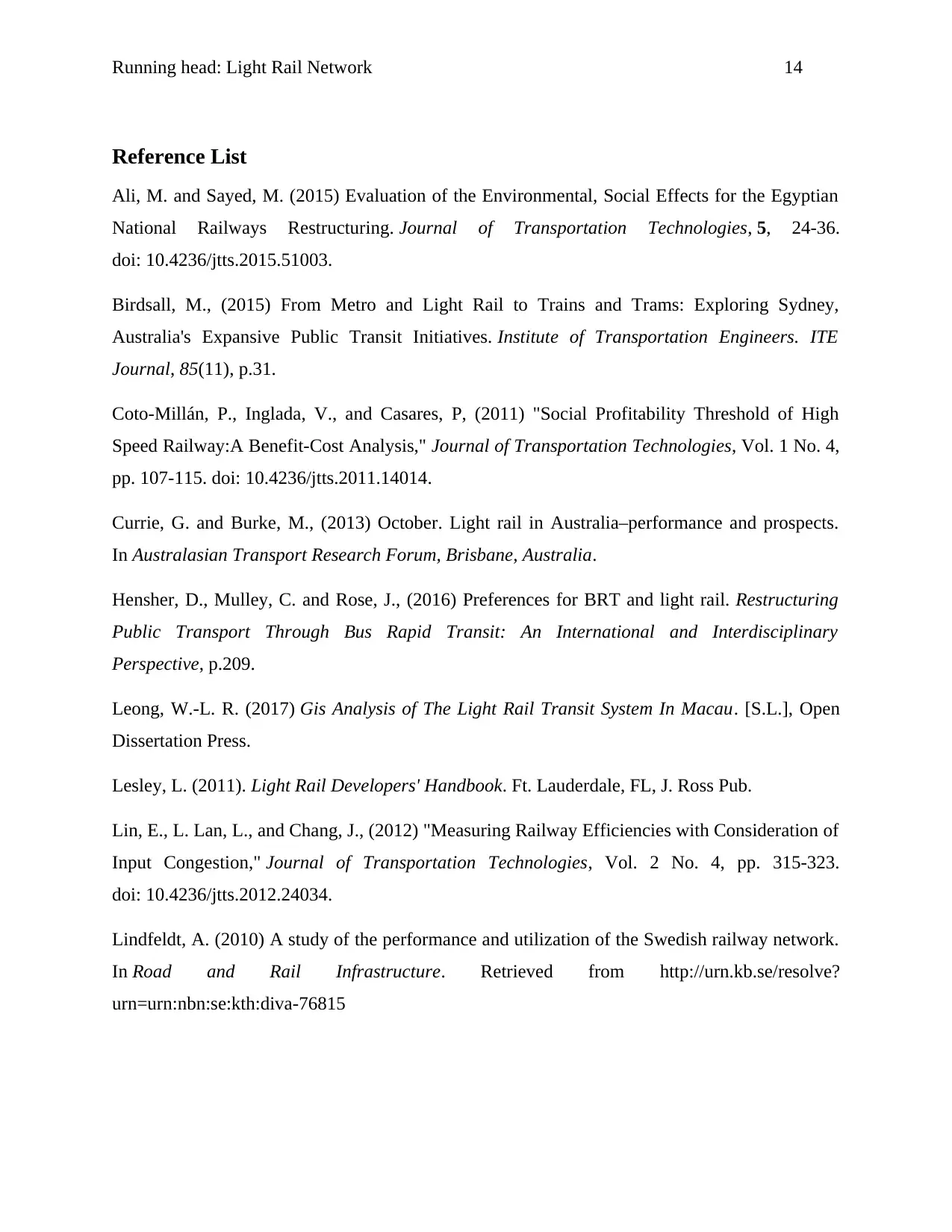
Running head: Light Rail Network 14
Reference List
Ali, M. and Sayed, M. (2015) Evaluation of the Environmental, Social Effects for the Egyptian
National Railways Restructuring. Journal of Transportation Technologies, 5, 24-36.
doi: 10.4236/jtts.2015.51003.
Birdsall, M., (2015) From Metro and Light Rail to Trains and Trams: Exploring Sydney,
Australia's Expansive Public Transit Initiatives. Institute of Transportation Engineers. ITE
Journal, 85(11), p.31.
Coto-Millán, P., Inglada, V., and Casares, P, (2011) "Social Profitability Threshold of High
Speed Railway:A Benefit-Cost Analysis," Journal of Transportation Technologies, Vol. 1 No. 4,
pp. 107-115. doi: 10.4236/jtts.2011.14014.
Currie, G. and Burke, M., (2013) October. Light rail in Australia–performance and prospects.
In Australasian Transport Research Forum, Brisbane, Australia.
Hensher, D., Mulley, C. and Rose, J., (2016) Preferences for BRT and light rail. Restructuring
Public Transport Through Bus Rapid Transit: An International and Interdisciplinary
Perspective, p.209.
Leong, W.-L. R. (2017) Gis Analysis of The Light Rail Transit System In Macau. [S.L.], Open
Dissertation Press.
Lesley, L. (2011). Light Rail Developers' Handbook. Ft. Lauderdale, FL, J. Ross Pub.
Lin, E., L. Lan, L., and Chang, J., (2012) "Measuring Railway Efficiencies with Consideration of
Input Congestion," Journal of Transportation Technologies, Vol. 2 No. 4, pp. 315-323.
doi: 10.4236/jtts.2012.24034.
Lindfeldt, A. (2010) A study of the performance and utilization of the Swedish railway network.
In Road and Rail Infrastructure. Retrieved from http://urn.kb.se/resolve?
urn=urn:nbn:se:kth:diva-76815
Reference List
Ali, M. and Sayed, M. (2015) Evaluation of the Environmental, Social Effects for the Egyptian
National Railways Restructuring. Journal of Transportation Technologies, 5, 24-36.
doi: 10.4236/jtts.2015.51003.
Birdsall, M., (2015) From Metro and Light Rail to Trains and Trams: Exploring Sydney,
Australia's Expansive Public Transit Initiatives. Institute of Transportation Engineers. ITE
Journal, 85(11), p.31.
Coto-Millán, P., Inglada, V., and Casares, P, (2011) "Social Profitability Threshold of High
Speed Railway:A Benefit-Cost Analysis," Journal of Transportation Technologies, Vol. 1 No. 4,
pp. 107-115. doi: 10.4236/jtts.2011.14014.
Currie, G. and Burke, M., (2013) October. Light rail in Australia–performance and prospects.
In Australasian Transport Research Forum, Brisbane, Australia.
Hensher, D., Mulley, C. and Rose, J., (2016) Preferences for BRT and light rail. Restructuring
Public Transport Through Bus Rapid Transit: An International and Interdisciplinary
Perspective, p.209.
Leong, W.-L. R. (2017) Gis Analysis of The Light Rail Transit System In Macau. [S.L.], Open
Dissertation Press.
Lesley, L. (2011). Light Rail Developers' Handbook. Ft. Lauderdale, FL, J. Ross Pub.
Lin, E., L. Lan, L., and Chang, J., (2012) "Measuring Railway Efficiencies with Consideration of
Input Congestion," Journal of Transportation Technologies, Vol. 2 No. 4, pp. 315-323.
doi: 10.4236/jtts.2012.24034.
Lindfeldt, A. (2010) A study of the performance and utilization of the Swedish railway network.
In Road and Rail Infrastructure. Retrieved from http://urn.kb.se/resolve?
urn=urn:nbn:se:kth:diva-76815

Running head: Light Rail Network 15
Lindfeldt, A. (2015) Railway capacity analysis : Methods for simulation and evaluation of
timetables, delays and infrastructure (PhD dissertation). Stockholm. Retrieved from
http://urn.kb.se/resolve?urn=urn:nbn:se:kth:diva-172916
Mandri-Perrott, X. C., and Menzies, I. (2010) Private sector participation in light rail-light
metro transit initiatives. Washington, DC, World Bank.
Murdock, V. (2013) Capitol Hill Design Guidelines: Vanessa Murdock, DPD Capitol Hill light
rail station sites development agreement and site-specific design guidelines EXH B, May 7,
2013, version #4. [Seattle?], [Dept. of Planning and Development?].
Nurul Kamila Mohd Yusof, (2011) Users perception on the effectiveness of light rail transit
system in Klang Valley. Academic exercise (B.A.) -- Jabatan Geografi, Fakulti Sastera dan Sains
Sosial, 2010/2011.
Parsons, Brinckerhoff, Quade and Douglas, (2012) Transit Cooperative Research Program, &
United States. Track design handbook for light rail transit.
Yang, Q. (2015) Research on Operation Cost-Benefits of China High-Speed Railway. Open
Journal of Social Sciences, 3, 42-47. doi: 10.4236/jss.2015.33009.
Ye, Y. , Shen, J. and Bergqvist, R., (2014) High-Capacity Transport Associated with Pre- and
Post-Haulage in Intermodal Road-Rail Transport. Journal of Transportation Technologies, 4,
289-301. doi: 10.4236/jtts.2014.43026.
Lindfeldt, A. (2015) Railway capacity analysis : Methods for simulation and evaluation of
timetables, delays and infrastructure (PhD dissertation). Stockholm. Retrieved from
http://urn.kb.se/resolve?urn=urn:nbn:se:kth:diva-172916
Mandri-Perrott, X. C., and Menzies, I. (2010) Private sector participation in light rail-light
metro transit initiatives. Washington, DC, World Bank.
Murdock, V. (2013) Capitol Hill Design Guidelines: Vanessa Murdock, DPD Capitol Hill light
rail station sites development agreement and site-specific design guidelines EXH B, May 7,
2013, version #4. [Seattle?], [Dept. of Planning and Development?].
Nurul Kamila Mohd Yusof, (2011) Users perception on the effectiveness of light rail transit
system in Klang Valley. Academic exercise (B.A.) -- Jabatan Geografi, Fakulti Sastera dan Sains
Sosial, 2010/2011.
Parsons, Brinckerhoff, Quade and Douglas, (2012) Transit Cooperative Research Program, &
United States. Track design handbook for light rail transit.
Yang, Q. (2015) Research on Operation Cost-Benefits of China High-Speed Railway. Open
Journal of Social Sciences, 3, 42-47. doi: 10.4236/jss.2015.33009.
Ye, Y. , Shen, J. and Bergqvist, R., (2014) High-Capacity Transport Associated with Pre- and
Post-Haulage in Intermodal Road-Rail Transport. Journal of Transportation Technologies, 4,
289-301. doi: 10.4236/jtts.2014.43026.
1 out of 15
Related Documents
Your All-in-One AI-Powered Toolkit for Academic Success.
+13062052269
info@desklib.com
Available 24*7 on WhatsApp / Email
![[object Object]](/_next/static/media/star-bottom.7253800d.svg)
Unlock your academic potential
© 2024 | Zucol Services PVT LTD | All rights reserved.





